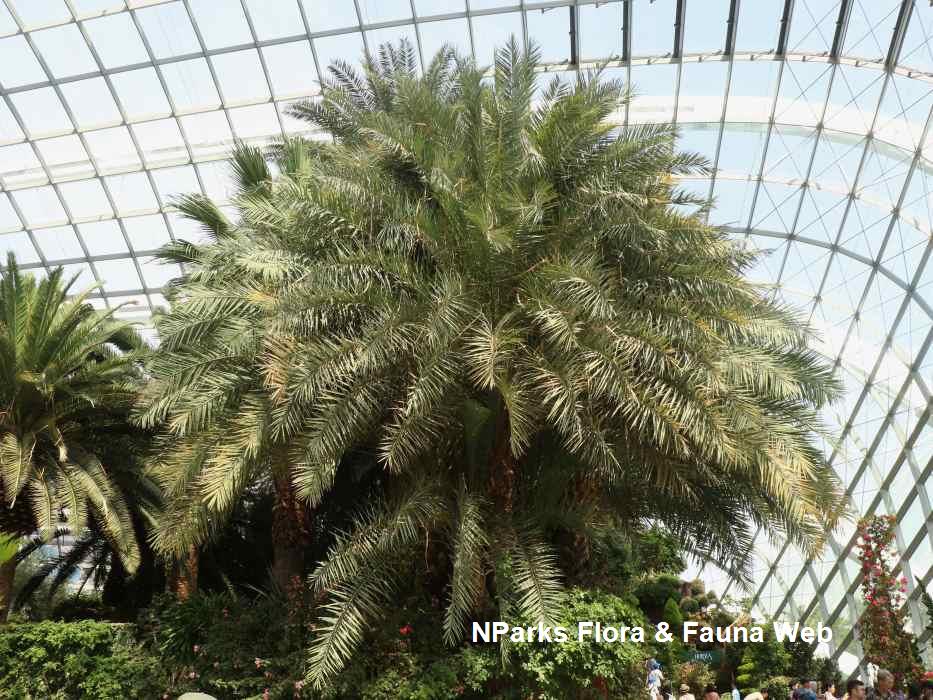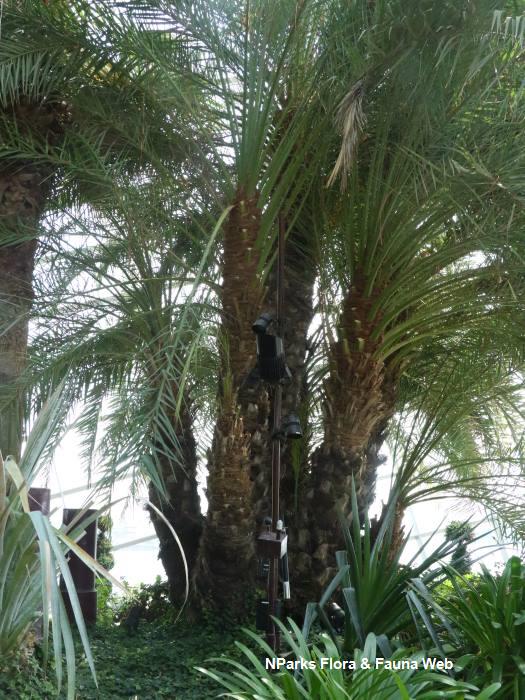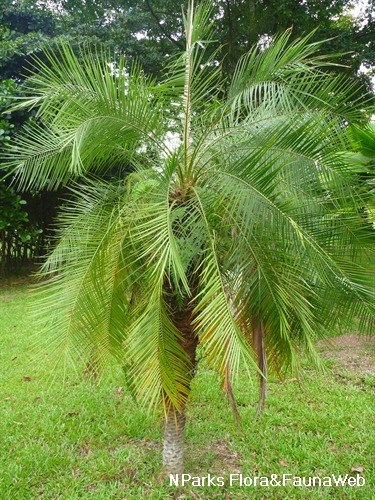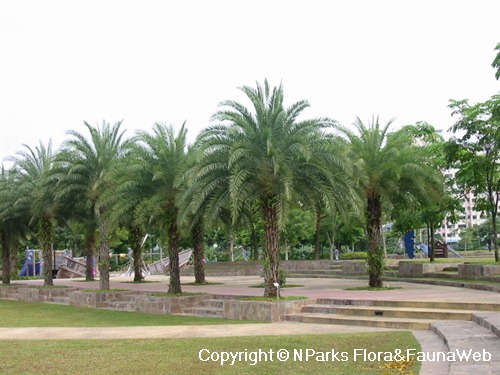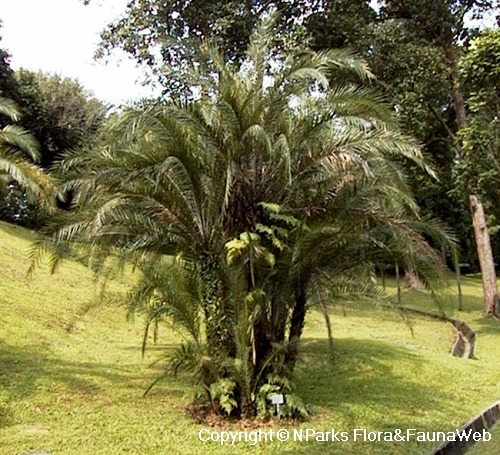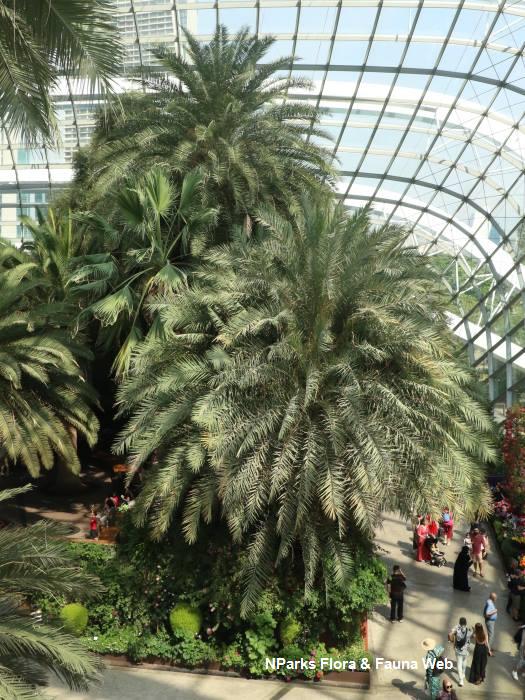
Back
Phoenix dactylifera L.
| Family Name: | Arecaceae (Palmae) |
| Synonyms: | Palma major Garsault, Phoenix atlantica var. maroccana A.Chev, Phoenix chevalieri D.Rivera, S.Ríos & Obón, Phoenix iberica D.Rivera, S.Ríos & Obón |
| Common Name: | Date, Date Palm |
Name
Classifications and Characteristics
| Plant Division | Angiosperms (Flowering Seed Plants) (Monocotyledon) |
|---|---|
| Plant Growth Form | Palm (Clustered Habit, Solitary Habit) |
| Lifespan (in Singapore) | Perennial |
| Mode of Nutrition | Autotrophic |
Biogeography
| Native Distribution | Gulf States, Iran, Iraq, Oman, Pakistan, Saudi Arabia |
|---|---|
| Native Habitat | Terrestrial (Desert / Semi-Desert) |
| Preferred Climate Zone | Desert / Arid |
| Local Conservation Status | Non-native |
Description and Ethnobotany
| Growth Form | It is a palm that reaches up to 15 - 25 m (rarely 30 m) tall, and can have a solitary or clustering growth habit. |
|---|---|
| Trunk | The trunk is 40 - 60 cm in diameter, often with a much broader base. |
| Foliage | The fronds are pinnately compound, dark green, and up to 3 - 5 m long. The leaflet can be 20 - 40 cm long and closely spaced along the rachis. Long, sharp spines are present at the bases of the fronds, which are formed from modified leaflets. |
| Flowers | The inflorescence is a panicle. The species is dioecious, meaning male and female flowers are found on separate plants. |
| Fruit | The fruit is highly variable in shape and size, measuring 4-7 cm long × 2-3 cm wide, and ripening into a range of colours from yellow and green to orange, red, purplish-brown, and black. The flesh is sweet, thick and fleshy or dry and thin. Seed variable in size and shape but generally elongate, up to 20 - 30 cm long × 5 - 8 mm wide, with tips rounded or pointed. |
| Similar | It can be found in the desert. |
| Cultivation | It can be propagated by seed. |
| Ethnobotanical Uses | Edible Plant Parts : Edible Fruits Food (Fruit or Vegetable) |
Plant Care and Propagation
| Light Preference | Full Sun |
|---|---|
| Water Preference | Moderate Water |
| Plant Growth Rate | Moderate |
| Rootzone Tolerance | Saline Soils / Salt Spray, Poor Infertile Soils, Low Humidity / Aircon, Drought Tolerant |
| Propagation Method | Seed |
Foliar
| Foliage Retention | Evergreen |
|---|---|
| Mature Foliage Colour(s) | Green |
| Foliar Type | Compound (Even-Pinnate) |
| Foliar Arrangement Along Stem | Spiral |
| Foliar Attachment to Stem | Petiolate |
| Foliar Shape(s) | Palm Fronds (Pinnate / Feather) |
| Leaf Area Index (LAI) for Green Plot Ratio | 2.5 (Palm - Solitary) |
Non - Foliar and Storage
| Trunk Type (Palm) | Aboveground, Solitary Habit, Clustering Habit |
|---|---|
| Root Type | Underground (Fibrous Root) |
Floral (Angiosperm)
| Flower & Plant Sexuality | Unisexual Flowers , Dioecious |
| Flower Colour(s) | Cream / Off-White |
|---|
| Flower Texture(s) | Thick / Fleshy |
| Flower Grouping | Cluster / Inflorescence |
| Flower Location | Axillary |
| Inflorescence Type | Panicle |
| Ovary Position | Inferior / Epipgynous |
| Flowering Habit | Polycarpic |
Fruit, Seed and Spore
| Mature Fruit Colour(s) | Yellow / Golden, Orange |
|---|---|
| Mature Fruit Texture(s) | Smooth |
| Fruit Classification | Simple Fruit |
| Fruit Type | |
| Mature Seed Colour(s) | Brown |
| Mature Seed Texture(s) | Smooth |
| Seed Quantity Per Fruit | Few (1-5) |
Image Repository
Others
| Master ID | 29101 |
|---|---|
| Species ID | 3414 |
| Flora Disclaimer | The information in this website has been compiled from reliable sources, such as reference works on medicinal plants. It is not a substitute for medical advice or treatment and NParks does not purport to provide any medical advice. Readers should always consult his/her physician before using or consuming a plant for medicinal purposes. |


